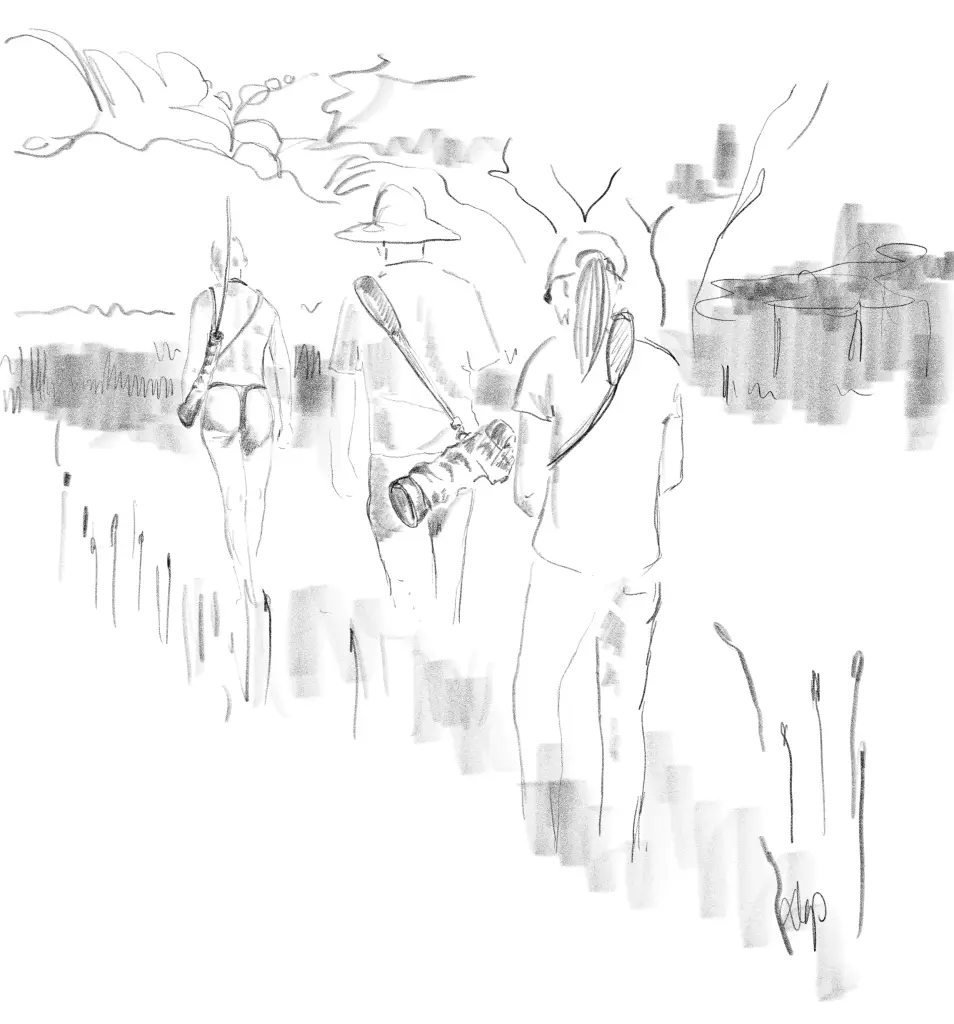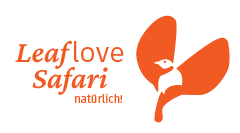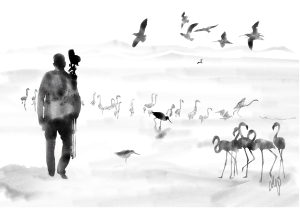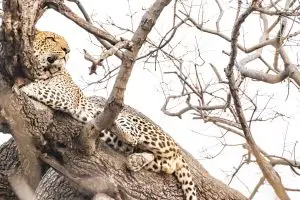The Spotted Arrow Poison Beetle, approximately 9mm long, yellow with black spots, lays its eggs on only two of Namibia’s Acacia tree species. The larva, resembling a fly maggot, drops to the ground after maturation and burrows up to a meter deep into the soil. Here, the larva pupates and provides the San hunter with potent arrow poison. Sometimes, the larva has an unwelcome guest. A ground beetle attaches itself and feeds on the pupa. The parasitic larva looks nearly identical to the host larva. When a San hunter finds one of these parasitic larvae, there is great joy because it is believed to be ‘even more poisonous!

It won’t be long before the ‘real’ Bushmen no longer exist. Today, the numerous indigenous peoples are referred to as San (pronounced Saan), which suggests ‘Forager’ or wandering gatherers. Those who wish to get to know this truly indigenous people of Namibia should hurry. When it comes to the expulsion of the Bushmen, we are all equally responsible, whether Herero, Ovambo, even Damara, and we remnants of the colonial era.
Today, debates revolve around wars, whether there was a genocide or not, who truly owns which land, who has the right to it, and who bears responsibility for the past. Somehow, the Bushmen as the true indigenous inhabitants seem to have been completely forgotten in this discussion. Even the fact that they were recently politically displaced from the Caprivi has not sparked much international interest.
It’s convenient when the indigenous people are generally peaceful and humble…
The Bushmen possessed an immense knowledge of herbal medicine. Learning from them rather than expelling them was only realized when it was already too late. Unfortunately, much too late. What would we give today for the knowledge of yesterday, instead of being preoccupied with the newspaper of tomorrow?

The so-called ‘Bushmanwalk’ has become a popular activity at some lodges, and tourists often marvel at what is humorously presented by a loincloth-wearing guide in the field. I often feel embarrassed during these walks because I am probably one of the few people who had the privilege of experiencing the teachings of Reinhard Friederich (author of the book: Verjagt… Verweht… Vergessen… Die Hai//om und das Etoschagebiet).
Reinhard Friederich grew up with the Bushmen and, as the Bushmen themselves might affectionately claim, he can speak the language of the Hai//om better than they can. After an informative lecture, we embarked on an unadulterated journey into the bush, and we received the most authentic ‘Bushmanwalk’ there ever was or will be. For health reasons, Reinhard Friederich no longer offers these walks.
Read the book! The Bushmen deserve it. You can find the information in a footnote!
If you want to experience the Bushmen somewhat authentically today, a small group in the Erongo Mountains offers a living museum. They demonstrate how the indigenous people and nomads once lived, how to set traps, find water, and go hunting… it’s truly worth a visit!
Even more authentic would be to join us in traveling to Tsumkwe in northeastern Namibia and visit the Bushmen there, amidst the imposing camelthorn trees.
The Hai//om people primarily used the Bushman’s Rose, which belongs to the dogbane family, as their poison. This extremely cardiotoxic poison is said to surpass all other arrow poisons, according to Friederich.
The Kalahari peoples, yes, among the Bushmen, there are different tribes with their own languages/dialects and ways of bush life, primarily used the poison from the caterpillar.
The next time you have an Amarula, remember that the jewel beetle Polyclada flexuosa specifically utilizes the marula tree, and hunters would dig up the pupae under these trees to capture the insect featured on the label of the sweet drink.
Ten larvae for one arrow, carefully and isolated from family and children, applied in various ways to the shaft of the arrowhead wrapped with fiber. One tribe presses the larvae directly onto the shaft, another dries them and mixes them with sticky plant sap, while another uses fresh plant sap mixed with spit and incorporates the larval poison.

How quickly the poison works… there are significant variations. Since Bushmen are skilled trackers and have time, the targeted prey, whether it’s a klipspringer or an elephant, is assured. The breakdown of hemoglobin and the resulting paralysis is scientifically proven, but the speed of it remains a subject of debate.
Could someone please tell me how the Bushmen knew that a meter below the ground, there lives a larva that can be used as arrow poison?
See you soon, yours,
Albert
Facts for Fact-checkers
(Here, I write ‘under correction please’ as I am not an expert in this field)
The term ‘Bushman’ is considered rather derogatory by some. Since the 1990s, ‘San’ has been more commonly used to describe these people:
Tribes:
The symbols in the tribal names represent clicks and sounds that are common in the Khoe-San language group.
The ǃKung (ǃXuun) tribe is divided into ǂKxʼaoǁʼae (Auen), Juǀʼhoan, and other groups. The Tuu tribe is divided into ǀXam, Nusan (Nǀu), ǂKhomani, and other groups. The Tshu–Khwe tribe is divided into Khwe (Khoi, Kxoe), Haiǁom, Naro, Tsoa, Gǁana (Gana), and Gǀui (ǀGwi).
Arrow Poison Beetles:
Family: Leaf beetles (Chrysomelidae), Subfamily: Galerucinae, Tribe: Flea beetles (Alticini)
(Names are often interchangeable and frequently changed):
Diamphidia simplex
Diamphidia nigroornata
Diamphidia vittatipennis
Diamphidia femoralis
Diamphidia locusta
Diamphidia lesnei
Diamphidia vitatta
Polyclada flexuosa
Lebistina holubi (Family: Carabidae, Ground beetles) Lebistina peringuey (Family: Carabidae, Ground beetles)
Host Plants:
(Names are often interchangeable and commonly changed)
Commiphora kwebensis (likely an older name…)
Commiphora angolensis – “Sand Corkwood”
Commiphora africana – “Hairy Corkwood” or “Poison-grub Commiphora”
Sclerocarya birrea caffra – Marula
Last Updated on 4. June 2024 by Albert Voigts von Schütz





